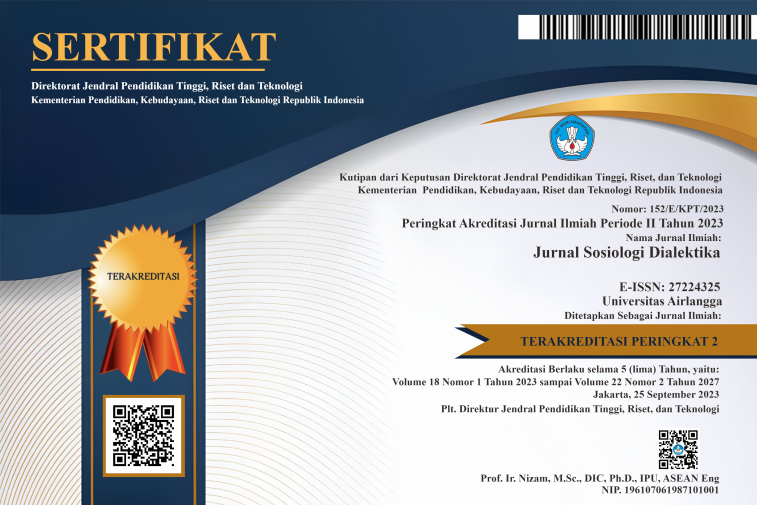Women's resistance to domestic violence during COVID-19 pandemic: A study from Indonesia
Downloads
COVID-19 pandemic affected the increasing frequency and intensity of a husband and wife's interaction. The pandemic further worsened domestic violence experienced by women, and this has made them resist the violence. This study aims to unravel domestic violence and women's resistance. The research used a qualitative method on women who experienced domestic violence amid the COVID-19 pandemic. The findings suggest that the resistance was triggered by numerous internal conflicts, such as declining income and increasingly diverse household conflicts during the pandemic. Women spontaneously resist against verbal, physical, and psychological abuse to save themselves from harm and to protect their dignity. The resistances are demonstrated in various ways, including fighting the husband back, verbal abuse, shouting, threatening to divorce, scratching, and punching the husband. Additionally, women also resorted to passive resistance by giving the silent treatment, staying away, stopping communication, not sleeping in the same bed, and refusing to serve the husband. This resistance exhibited women's awareness to defend their rights. Women did realize that they have the right to fight back as a manner of combating gender inequality.
Ahmed AM & Elmardi AE (2005) A study of domestic violence among women attending a medical centre in Sudan. La Revue de Santé de la Méditerranée orientale 11 (1-2):164-174.
Allen M (2011) Violence and voice: Using a feminist constructivist grounded theory to explore women's resistance to abuse. Qualitative Research 11 (1):23-45.
Anderson KL & Umberson D (2001) Gendering violence. Gender & Society 15 (3):358–380.
Anderson AS & Lo CC (2010) Intimate partner violence within law enforcement families. Journal of Interpersonal Violence 26 (6):1176-1193.
Armstrong E (2004) Globalization from below: AIDWA, foreign funding, and gendering anti-violence campaigns. Journal of Developing Societies 20 (1-2):39-55.
Ballan MS & Freyer MB (2012) Self-defense among women with disabilities. Violence Against Women 18 (9):1083-1107.
Bhandari S, Bullock LFC, Anderson KM, Danis FS, & Sharps PW (2011) Pregnancy and intimate partner violence: How do rural, low-income women cope? Health Care for Women International 32 (9):833-854.
Bohall G, Bautista MJ, & Musson S (2016) Intimate partner violence and the Duluth Model: An examination of the model and recommendations for future research and practice. Journal of Family Violence 31 (8):1029-1033.
Bouffard LA, Wright KA, Muftić LR, & Bouffard JA (2008) Gender differences in specialization in intimate partner violence: Comparing the gender symmetry and violent resistance perspectives. Justice Quarterly 25 (3):570-594.
Brecklin LR (2002) The role of perpetrator alcohol use in the injury outcomes of intimate assaults. Journal of Family Violence 17 (3):185-197.
Brickell K (2015) Towards intimate geographies of peace? Local reconciliation of domestic violence in Cambodia. Transactions of the Institute of British Geographers 40 (3):321-333.
Burman E, Smailes SL, & Chantler K (2004) ‘Culture' as a barrier to service provision and delivery: Domestic violence services for minoritized women. Critical Social Policy 24 (3):332-357.
Burnette CE (2015) Disentangling indigenous women's experiences with intimate partner violence in the United States. Critical Social Work 16 (1).
Callaghan J (2015) Mothers and children? Representations of mothers in research on children's outcomes in domestic violence. Psychology of Women Section Review 17: 13-20.
Campbell C & Mannell J (2015) Conceptualising the agency of highly marginalised women: Intimate partner violence in extreme settings. Global Public Health 11 (1-2):1-16.
Cavanagh K (2003) Understanding women's responses to domestic violence. Qualitative Social Work: Research and Practice 2 (3):229-249.
Childress S, Gioia D, & Campbell JC (2017) Women's strategies for coping with the impacts of domestic violence in Kyrgyzstan: A grounded theory study. Social Work in Health Care 57 (3):164-189.
Chimah UC, Adogu POU, & Ilika AL (2015) Impact of intimate partner violence and coping strategies adopted among women in military and civilian communities of Abuja Nigeria. Scholars Journal of Applied Medical Sciences (SJAMS) 3 (1B):131-138.
Dasgupta SD (2002) A Framework for understanding women's use of nonlethal violence in intimate heterosexual relationships. Violence Against Women 8 (11):1364-1389.
DeKeseredy WS & Dragiewicz M (2007) Understanding the complexities of feminist perspectives on woman abuse: A commentary on Donald G. Dutton's rethinking domestic violence. Violence Against Women 13 (8):874-884.
Dhungel S, Dhungel P, Dhital SR, & Stock C (2017) Is economic dependence on the husband a risk factor for intimate partner violence against female factory workers in Nepal? BMC Women's Health 17 (1).
Esqueda CW & Harrison LA (2005) The influence of gender role stereotypes, the woman's race, and level of provocation and resistance on domestic violence culpability attributions. Sex Roles 53 (11-12):821-834.
Flowers R (2015) Refusal to forgive: Indigenous women's love and rage. Decolonization: Indigeneity, Education & Society 4 (2):32-49.
Fulu E & Miedema S (2015) Globalization and changing family relations: Family violence and women's resistance in Asian Muslim societies. Sex Roles 74 (11-12):480-494.
Galtung J (1990) Cultural violence. Journal of Peace Research 27 (3). https://doi.org/10.1177%2F0022343390027003005.
Goodman L, Dutton MA, Weinfurt K, & Cook S (2003) The intimate partner violence strategies index. Violence Against Women 9 (2):163-186.
Goodman L, Dutton MA, Vankos N, & Weinfurt K (2005) Women's resources and use of strategies as risk and protective factors for reabuse over time. Violence Against Women 11 (3):311-336.
Gulliver P & Fanslow JL (2015) The Johnson typologies of intimate partner violence: An investigation of their representation in a general population of New Zealand women. Journal of Child Custody 12 (1):25-46.
Hall N (2009) East Timorese women challenge domestic violence. Australian Journal of Political Science 44 (2):309-325.
Hardesty JL & Ganong LH (2006) How women make custody decisions and manage co-parenting with abusive former husbands. Journal of Social and Personal Relationships 23 (4):543-563.
Hollander JA (2005) Challenging despair: Teaching about women's resistance to violence. Violence Against Women 11 (6):776-791.
Hollander JA (2009) The roots of resistance to women's self-defense. Violence Against Women 15 (5):574-594.
Hollander JA & Einwohner RL (2004) Conceptualizing resistance. Sociological Forum 19: 533-554. https://doi.org/10.1007/s11206-004-0694-5.
Hassouneh-Phillips D (2003) Strength and vulnerability: Spirituality in abused American Muslim women's lives. Issues in Mental Health Nursing 24 (6-7):681-694.
Javaid A (2015) The role of alcohol in intimate partner violence: Causal behaviour or excusing behaviour? British Journal of Community Justice 13 (1):75-92.
Jayanthi ET (2009) Faktor-faktor penyebab terjadinya kekerasan dalam rumah tangga pada survivor yang ditangani oleh lembaga sahabat perempuan Magelang. Dimensia 3 (2):33-50.
Jewkes R, Flood M, & Lang J (2015) From work with men and boys to changes of social norms and reduction of inequities in gender relations: A conceptual shift in prevention of violence against women and girls. The Lancet 385 (9977):1580-1589.
Johnson MP (2005) Domestic violence: It's not about gender-or is it? Journal of Marriage and Family 67 (5):1126-1130.
Johnson MP (2006) Conflict and control. Violence Against Women 12 (11):1003-1018.
Johnson MP (2011) Gender and types of intimate partner violence: A response to an anti-feminist literature review. Aggression and Violent Behavior 16 (4):289-296.
Kelly JB & Johnson MP (2008) Differentiation among types of intimate partner violence: Research update and implications for interventions. Family Court Review 46 (3):476-499.
Kernsmith P (2010) Treating perpetrators of domestic violence: Gender differences in the applicability of the theory of planned behavior. Sex Roles 52: 757-770.
Kocot T & Goodman L (2003) The roles of coping and social support in battered women's mental health. Violence Against Women 9 (3):323-346.
Labronici LM (2012) Resilience in women victims of domestic violence: A phenomenologicalview. Text Context Nursing, Florianópolis 21 (3):625-632.
Leclerc B, Chiu YN, Cale J, & Cook A (2016) Sexual violence against women through the lens of environmental criminology: Toward the accumulation of evidence-based knowledge and crime prevention. European Journal on Criminal Policy and Research 22 (4):593-617.
LeCouteur A & Oxlad M (2010) Managing accountability for domestic violence: Identities, membership categories and morality in perpetrators' talk. Feminism & Psychology 21 (1):5-28.
Levesque DA, Velicer WF, Castle PH, & Greene RN (2008) Resistance among domestic violence offenders. Violence Against Women 14 (2):158-184.
Liang B, Goodman L, Tummala-Narra P, & Weintraub S (2005) A theoretical framework for understanding help-seeking processes among survivors of intimate partner violence. American Journal of Community Psychology 36 (1-2):71-84.
Lichtenstein B & Johnson IM (2009) Older African American women and barriers to reporting domestic violence to law enforcement in the rural deep south. Women & Criminal Justice 19 (4):286-305.
Marshall GA & Furr LA (2010) Factors that affect women's attitudes toward domestic violence in Turkey. Violence and Victims 25 (2):265-277.
Mary M (2020) Coping strategies of women intimate partner violence survivors: Perspectives of service providers. Thesis, University of Saskatchewan, Canada.
Mason C (2005) Women, violence and nonviolent resistance in East Timor. Journal of Peace Research 42 (6):737-749.
Mason G & Pulvirenti M (2013) Former refugees and community resilience: "Papering over” domestic violence. British Journal of Criminology 53 (3):401-418.
McCarthy M, Hunt S, & Milne-Skillman K (2016) "I know it was every week, but i can”t be sure if it was every day: Domestic violence and women with learning disabilities. Journal of Applied Research in Intellectual Disabilities 30 (2):269-282.
Meyer A, Wagner B, & Dutton MA (2009) The relationship between battered women's causal attributions for violence and coping efforts. Journal of Interpersonal Violence 25 (5):900-918.
Miller SL & Meloy ML (2006) Women's use of force: Voices of women arrested for domestic violence. Violence Against Women 12 (1):89-115.
Mkandawire-Valhmu L, Bauer WS, Stevens PE, Galvao LW, Grande KM, Yerges A, & Weinhardt L (2016) Rural Malawian women's resistance to systematic oppression, violence, and abuse by their husbands. Journal of Interpersonal Violence. https://doi.org/10.1177/0886260516682518.
Muftić LR, Bouffard JA, & Bouffard LA (2007) An exploratory study of women arrested for intimate partner violence. Journal of Interpersonal Violence 22 (6):753-774.
Muftić LR, Finn MA, & Marsh EA (2012) The victim-offender overlap, intimate partner violence, and sex. Crime & Delinquency 61 (7):899-926.
Myhill A (2017) Measuring domestic violence: Context is everything. Journal of Gender-Based Violence 1 (1):33-44.
Nurhayati SR (2005) Atribusi kekerasan dalam rumah tangga, kesadaran terhadap kesetaraan gender, dan strategi menghadapi masalah pada perempuan korban kekerasan dalam rumah tangga. Thesis, Universitas Gadjah Mada, Yogyakarta.
Payne D & Wermeling L (2009) Domestic violence and the female victim: The real reason women stay. Journal of Multicultural, Gender and Minority Studies 3 (1).
Purvin DM (2003) Weaving a tangled safety net: The intergenerational legacy of domestic violence and poverty. Violence Against Women 9 (10):1263-1277.
Radford L & Tsutsumi K (2004) Globalization and violence against women”inequalities in risks, responsibilities and blame in the UK and Japan. Women's Studies International Forum 27 (1):1-12.
Rajah V (2007) Resistance as edgework in violent intimate relationships of drug -involved women. The British Journal of Criminology 47 (2):196-213.
Randall M (2010) Sexual assault law, credibility, and "ideal victims”: Consent, resistance, and victim blaming. Canadian Journal of Women and the Law 22 (2):397-433.
Rizo CF (2013) The coping efforts of intimate partner violence survivors: Review of the literature, exploratory inquiry, and scale development. Thesis, The University of North Carolina, USA.
Rizo CF (2015) Intimate partner violence related stress and the coping experiences of survivors: "There's only so much a person can handle.” Journal of Family Violence 31 (5):581-593.
Rizo CF, Givens A, & Lombardi B (2017) A systematic review of coping among heterosexual female IPV survivors in the United States with a focus on the conceptualization and measurement of coping. Aggression and Violent Behavior 34: 35-50.
Sayem AM, Begum HA, & Moneesha SS (2013) Women's attitudes towards formal and informal support-seeking coping strategies against intimate partner violence. International Social Work 58 (2):270-286.
Scarduzio J A, Carlyle K E, Harris KL, & Savage MW (2016) "Maybe she was provoked.” Violence Against Women 23 (1):89-113.
Schaefer LM, Howell KH, Sheddan HC, Napier TR, Shoemaker HL, & Miller-Graff LE (2019) The road to resilience: Strength and coping among pregnant women exposed to intimate partner violence. Journal of Interpersonal Violence. https://doi.org/10.1177/0886260519850538.
Scott KL & King CB (2007) Resistance, reluctance, and readiness in perpetrators of abuse against women and children. Trauma, Violence, & Abuse 8 (4):401-417.
Serran G & Firestone P (2004) Intimate partner homicide: a review of the male proprietariness and the self-defense theories. Aggression and Violent Behavior 9 (1):1-15.
Sokoloff NJ & Dupont I (2005) Domestic violence at the intersections of race, class, and gender. Violence Against Women 11 (1):38-64.
Stuart GL (2010) The association between impulsivity, trait anger, and the perpetration of intimate partner and general violence among women arrested for domestic violence. Journal of Interpersonal Violence 26 (13):2681-2697.
Sugg N (2015) Intimate partner violence. Medical Clinics of North America 99 (3):629-649.
Sukmawati B (2014) Hubungan tingkat kepuasan pernikahan istri dan coping strategy dengan kekerasan dalam rumah tangga. Jurnal Sains dan Praktik Psikologi 2 (5):205-218.
Todd N, Wade A, & Renoux M (2004) Coming to terms with violence and resistance. In: Strong T & Paré D (Eds) Furthering Talk. Boston: Springer.
Vecina ML, Marzana D, & Paruzel-Czachura M (2015) Connections between moral psychology and intimate partner violence: Can IPV be read through moral psychology? Aggression and Violent Behavior 22:120-127.
Walby S (1990) Theorizing Patriarchy. Oxford: Basil Blackwell Ltd.
Walton-Moss BJ, Manganello J, Frye V, & Campbell JC (2005) Risk factors for intimate partner violence and associated injury among urban women. Journal of Community Health 30 (5):377-389.
Warner K, Baro A, & Eigenberg H (2005) Stories of resistance. Journal of Feminist Family Therapy 16 (4):21-42.
Whitaker MP (2013) Motivational attributions about intimate partner violence among male and female perpetrators. Journal of Interpersonal Violence 29 (3):517-535.
Wilson D, Smith R, Tolmie J, & de Haan I (2015) Becoming better helpers: Rethinking language to move beyond simplistic responses to women experiencing intimate partner violence. Policy Quarterly 11 (1):25-31.
Yount KM (2005) Resources, family organization, and domestic violence against married women in Minya, Egypt. Journal of Marriage and Family 67 (3):579-596. https://doi.org/10.1111/j.1741-3737.2005.00155.x.
Yount KM (2010) Women's conformity as resistance to intimate partner violence in Assiut, Egypt. Sex Roles 64 (1-2):43–58.
Zink T, Jacobson CJ, Pabst S, Regan S, & Fisher BS (2006) A lifetime of intimate partner violence. Journal of Interpersonal Violence 21 (5):634-651.
1. Copyright of this journal is possession of Editorial Board and Journal Manager, by the knowledge of author, whilst the moral right of the publication belongs to the author.
2. Legal formal aspect of journal publication accessibility refers to Creative Commons Attribution-NonCommercial-ShareAlike (CC BY-NC-SA), implies that publication can be used for non-commercial purposes in its original form (cannot be modified).
3. Every publications (printed/electronic) are open access for educational purposes, research, and library. Other that the aims mentioned above, editorial board is not responsible for copyright violation.















